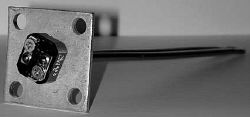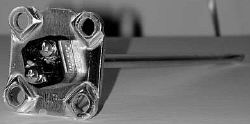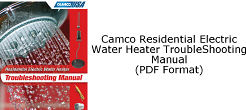|
Water Heater Element Selection Guide

It is important to the success of the repair job and the life of the water heater that the proper element be matched to the heater. We have prepared this guide to help in determining which element is the correct one for your water heater. Please note that this is just a guide, always consult your water heater manual or a licensed electrician or plumber if you are unfamiliar with any of these terms or if you feel uncomfortable in attempting the repair job yourself.
In order to determine the correct element for your water heater there are three factors to consider: Element Flange Style, Voltage/Wattage & Watt-Density.
|
| Step 1: Determine your Element Flange Style |
 Screw-In Flange
Screw-In Flange
This style is used on all new residential water heaters.
1" (diameter) x 11-1/2 NPSM thread and is standard for all residential water heaters that use screw-in elements.
EXCEPTION: For a period of time, State Industries manufactured a Duron brand heater that used a 1-3/8" thread. These elements are not interchangeable with the standard 1" threaded element.
Fits most GE, Rheem, Rudd, Richmond, State, Montgomery Ward, Sears/Kenmore, Norge, Westinghouse, Reliance, Noland, AO Smith, Bradford White, GS Wood, Maytag and Duro-Matic water heaters, some Mor-Flo, American and Craftmaster prior to 1991 and all water heaters manufactured after 1994.
Important: You will need a Screw-In Element Wrench to remove and
install screw-in elements. We offer two wrenches and one socket
for this task. See our Camco
Screw-In Element Wrenches for details. |
 Flat Flange
Flat Flange
Older style element.
Bolted to the tank with four 3/8" bolts.
Note: The Camco
Element Universal Adapter Kit will adapt a screw-in style element
to a bolt-in style element that can replace the above element.
Fits most older Mor-Flo, American, Craftmaster, some older State, Reliance, Rheem, Rudd, Richmond, Montgomery Ward, Norge, Intertherm and Westinghouse models. Fits some Briggs, Bradford-White, U.S. Water Heater, Republic, Day and Night, Jackson, Tennessee Tank and Duro-Matic. |
 Universal Flange
Universal Flange
Older style element.
Bolted to the tank with four 3/8" bolts.
Note: The Camco
Element Universal Adapter Kit will adapt a screw-in style element
to a bolt-in style element that can replace the above element.
Fits older Bradford-White, U.S. Water Heater, most D&R, Day and Night, Briggs, Jackson, Tennessee Tank and early models of State and A.O. Smith. |
 Round Head Style Flange
Round Head Style Flange
Older style element.
Secured to the tank with a separate 4-bolt flange.
Note: The Camco
Element Universal Adapter Kit will adapt a screw-in style element
to a bolt-in style element that can replace the above element.
Fits July 1975 or older models of State, Reliance, Sears, J.C. Penney, Crane and some A.O. Smith. |
| Step 2: Determine your Voltage/Wattage |
The majority of residential style water heaters use 240v power. The 120v elements are primarily used for smaller water heaters, point-of-use heaters and in locations where a 240v circuit is not available. The wattage rating, which determines the heat output, of the 240v elements can be anywhere from 1000 watts to 6000 watts. The wattage rating of 120v elements is 1000 watts to 2500 watts. Each model water heater is designed for a specific voltage/wattage rated element. The replacement element must be the same voltage and wattage as the element being replaced. Never exceed the nameplate rating on the water heater.
Check the nameplate on the heater to determine the proper voltage/wattage combination is correct for your heater. Unless your heater is small you will probably need a 240v element. |
| Step 2: Determine your Watt-Density |
|
The watt-density of an element is basically the amount of heat concentrated on any point on the surface of the element. The lower the watt-density, the greater the amount of element surface. The heat per square inch of the surface is reduced, but the total surface is increased so that the total heat of the element is the same for a particular wattage.
|
| Frequently asked questions about Water Heater Elements |
1. How do I know which water heater element to buy?
Consult our Water
Heater Element Selection Guide for help in choosing the
correct element for your heater.
2. What causes water heater elements to fail, some sooner than others?
Several reasons: power surges, lightning, dry-firing and lime build-up..
3. Why are some water heater elements folded back?
These are low watt-density (LWD) elements. The heat (watts) per square inch of surface has been lowered by 50% from that of a regular element. In order for total heat to be the same, the total surface has been increased. It is folded back so the length will fit the tank.
4. What are Lime Life elements?
These elements are Premium. They are made of nickel/stainless steel and are ultra low watt-density. These features prevent lime build-up and extend the life of the element. A Lime Life element resists dry-firing. These elements carry a limited 5 year manufacturer's warranty.
5. What is meant by the term “dry-firing?”
High watt density and low watt-density are designed to function in water. If not surrounded by water, the intense heat they generate (dry fire) will cause them to burn out. The water tank must be full of water whenever the power is on. Dry-fire failure is not covered by any warranty. It is a human error. Dry-fired elements are easily detected. The element is soft and easily bent. In most cases, a hole is burned through the surface.
6. Can I replace the element in my water heater with elements with higher wattage?
It is not recommended. The water heater is designed for that element size. Higher wattage might require heavier gauge wire and a larger capacity circuit breaker.
|
Safety Considerations:
While most water heater repair jobs can be accomplished with some basic tools, time and common sense please keep in mind the following safety considerations. Failure to follow these considerations may result in damage to the water heater or injury to yourself.
1. Always shut off power to the water heater at the electrical service panel (breaker box) before beginning any work. Never attempt to service a water heater without disconnecting power. There is ample voltage and amperage present to seriously injure or kill you.
2. If you are experienced with plumbing and electrical tools, you can do the repairs yourself. If you are at all hesitant, call a plumber or electrician.
3. If you are replacing a water heater element you must drain the tank. Never attempt to replace an element without draining the tank.
4. Never "dry-fire" a water heater element. Water heater elements are designed to operate only in water. Dry-firing an element will destroy the element in a few seconds.

Return to top of page |
|
|

